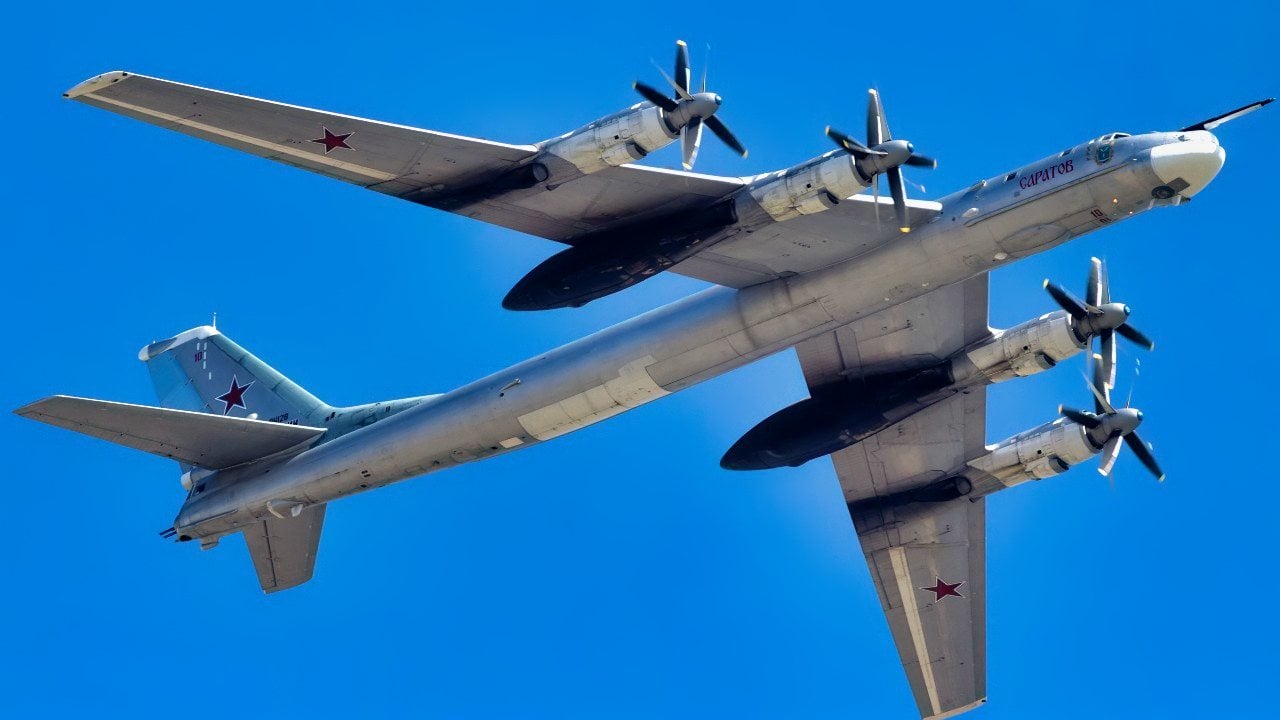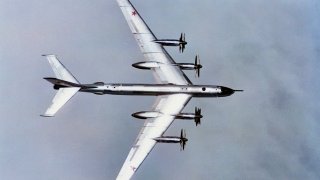Russian Tu-95MS Bombers Flew Right Next America's Doorstep
The Tupolev Tu-95MS (NATO reporting name "Bear-H"), a strategic bomber of the Russian Aerospace Forces, continues to conduct flights near Alaska, demonstrating Russia's commitment to its long-range aviation capabilities.
Summary: The Tupolev Tu-95MS (NATO reporting name "Bear-H"), a strategic bomber of the Russian Aerospace Forces, continues to conduct flights near Alaska, demonstrating Russia's commitment to its long-range aviation capabilities.
-Recently, two Tu-95MS bombers, escorted by Su-30SM fighters, flew over the neutral waters of the Bering Sea near Alaska's western coast, a flight that lasted over 11 hours and occurred within the Alaska Air Defense Identification Zone (ADIZ).
-These flights, which have been a regular practice since 2007 when President Vladimir Putin revived the Soviet-era tradition, are monitored by NORAD but are not considered a threat as they remain in international airspace. The Tu-95MS, a modernized version of the Cold War-era aircraft, symbolizes the enduring capability of Russian military aviation to project power far from its borders.
Russian Tu-95MS Bombers Patrol Near Alaska in a Display of Long-Range Aviation Prowess
It may be doubtful that Russian aviators know Johnny North's 1960 hit song "North to Alaska" – featured in the John Wayne movie of the same name – but it could be the anthem for pilots of the Tupolev Tu-95MS (NATO reporting name Bear-H), which has made an increasing number of flights near Alaska's western coast. The most recent flight occurred this week, lasting more than 11 hours.
"Two Tu-95MS strategic missile-carrying bombers of the Russian Aerospace Forces' long-range aviation carried out a scheduled flight in the airspace over the neutral waters of the Bering Sea near the western coast of Alaska. The flight lasted over 11 hours. The crews of Su-30SM aircraft of the Aerospace Forces provided fighter support," the Russian Ministry of Defense said in a statement to state media outlet Tass.
"At some stages of the route, the strategic missile-carrying bombers were escorted by fighter jets of foreign states," the ministry added.
A pair of Russian Sukhoi Su-30SM (NATO reporting name Flanker-H) fighters provided escort for the long-range strategic bombers. The four Russian aircraft flew inside the Alaska Air Defense Identification Zone (ADIZ) and were tracked by the North American Aerospace Defense Command (NORAD).
"The Russian aircraft remained in international airspace and did not enter American or Canadian sovereign airspace. This Russian activity in the Alaska ADIZ occurs regularly and is not seen as a threat," NORAD announced.
The flights near Russia have been occurring with disturbing regularity. It was in 2007 that Russian President Vladimir Putin revived the Soviet-era practice of sending bomber aircraft on regular patrols beyond Russia's borders.
According to TheAviationist.com, a United States Air Force F-16C Fighting Falcon from the 18th FIS (Fighter Interceptor Squadron) out of Eielson Air Force Base (AFB), Alaska, intercepted the Russian bombers. What was notable is that the unit was formerly the 18th Aggressor Squadron and the Fighting Falcon reportedly sported a typical aggressor camouflage color scheme.
Meet the Tu-95 Bear Bomber
The Tu-95MS is a highly updated heavy variant of the early Cold War era aircraft that first entered service in 1952, and it is now among the oldest aircraft designs still flying anywhere in the world, yet it continues to log the miles in the sky.
As the only propeller-powered bomber in operation, it is far from the fastest aircraft but it was designed so that it could fly a distance of 5,000 miles and strike targets within the United States from territory within the former Soviet Union. The current models have a reported range that is greater than 9,300 miles (15,000 km).
It was developed to be equipped with propeller-driven engines due to the fact that jet engines in the early 1950s simply burned through fuel far too quickly, and the Soviet Air Force lacked the capability to refuel its long-range aircraft in flight. The Tu-95 was meant to fly slow and steady, and the most recent version continues to do the same.
The Tu-95MS Bear-H is also the only frontline aircraft still equipped with a tail gunner's position! Even with the modernization efforts, the tail gunner still sits in a rear compartment that is isolated from the rest of the crew. It houses twin 23mm cannons that are meant to provide additional defense against fighter interceptors but lacks anything resembling creature comforts.
Symbol of Pride
It is unclear why NATO designated the Tu-95 as the "Bear," but the moniker was embraced by the Soviet Air Force – especially as the heavy bomber became a symbol of pride of the Soviet Union. It was touted to be much like the nation: rugged, hard-working, and simple in design (although Western analysts would debate that The Soviet Union was all that hard-working and the design was simplistic more than simple). It wasn't as flashy as the United States Air Force's B-52 Stratofortress, and that fact was evident as the Bear often appeared at European Air Shows.
A notable point about the Tu-95MS is that those airframes are actually far newer than the rival B-52. While the original Bears did enter service 70 years ago, when the Soviet Union sought to "modernize" the aircraft in the early 1980s, it was found that the aging airframes were essentially past their normal life. As a result, an entirely new batch of aircraft was produced as the Tu-95M – the modernized variant.
Those aircraft have been steadily upgraded as the MS variant, which remains a key element of the air component of Russia's nuclear triad, while also serving in a maritime reconnaissance role. The airframes have also been upgraded to carry the Kh-101/102 stealth cruise missiles.

Despite the fact that the original Tu-95s first entered service 70 years ago, the aircraft wasn't deployed in combat until 2015 – when a pair of Tu-95MS bombers were used in a series of long-range airstrikes as part of the Russian military intervention in Syria.
It now continues to make regular flights to the waters near Alaska.
Author Experience and Expertise: Peter Suciu
Peter Suciu is a Michigan-based writer. He has contributed to more than four dozen magazines, newspapers, and websites with over 3,200 published pieces over a twenty-year career in journalism. He regularly writes about military hardware, firearms history, cybersecurity, politics, and international affairs. Peter is also a Contributing Writer for Forbes and Clearance Jobs. You can follow him on Twitter: @PeterSuciu. You can email the author: [email protected].


